Which Way to the Wild West? (17 page)
Read Which Way to the Wild West? Online
Authors: Steve Sheinkin

S
tories of shootouts in the street make the Wild West sound a lot wilder that it really was. Historians point out that in the 1870s there was probably more violence in a typical week in New York City than there was in an entire month on the Great Plains.
tories of shootouts in the street make the Wild West sound a lot wilder that it really was. Historians point out that in the 1870s there was probably more violence in a typical week in New York City than there was in an entire month on the Great Plains.
Anyway, an occasional gunfight was hardly going to scare settlers away from the fertile farmland of the plains. After coming to Kansas from Sweden, Olof Olsson wrote to friends back home, explaining why so many people were still heading west: “The advantage which America offers is not to make everyone rich at once without toil and trouble, but the advantage is that the poor, who will and are able to work, secure a large piece of good land almost without cost.”
For Europeans who couldn't afford land at home, this was too good to resist. Hundreds of thousands of hopeful farmers poured in from Germany, Sweden, and Norway. One third of the entire population of Iceland moved to the Great Plains.
States actually competed with each other to attract these immigrant families. Kansas, Nebraska, and Minnesota were all eager to
grab Mennonite farmers from Russia. Followers of this religious group were looking for a new home with religious freedom and good farmland. When they arrived in Kansas, an agent working for the state of Nebraska stepped in. “I stole the whole bunch,” he boasted, “and carried them all by special train, free, to Lincoln, Nebraska.”
grab Mennonite farmers from Russia. Followers of this religious group were looking for a new home with religious freedom and good farmland. When they arrived in Kansas, an agent working for the state of Nebraska stepped in. “I stole the whole bunch,” he boasted, “and carried them all by special train, free, to Lincoln, Nebraska.”
Some stayed, though most went on to settle in Kansas. The important thing is that these Mennonite families brought a special type of wheat they had been growing on the dry Russian plains. This wheat thrived on the dry American plains too, helping turn the Great Plains into the most productive wheat-growing region in the world.
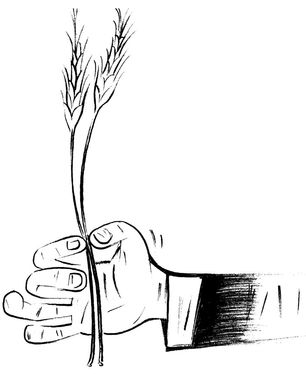
B
ut even while their crops thrived, pioneers on the plains still had to rough it.
ut even while their crops thrived, pioneers on the plains still had to rough it.
Every season brought its own special horrors. With the spring came the threat of floods, tornadoes, and hailstorms. Summers could bring 100-plus-degree heat, along with droughts and burning-hot winds. When the grasses dried out in the fall, wild prairie fires were a constant danger. “It is a strange and terrible sight to see all the fields a sea of fire,” said one Nebraska settler. “Quite often the scorching flames sweep everything along in their pathâpeople, cattle, hay, fences.”
Then came the long winters. Percy Ebbutt, the young pioneer from Britain, found no way to escape the cold. “While sitting round the red-hot stove at breakfast,” he reported, “one's coffee would freeze in a very short time if placed on the table a few feet from the fire.”
Like all successful pioneers, the Ebbutts found ways to adapt to the harsh conditions. If the temperature in your house is below freezing, for example, why not use it as a freezer? “We used to keep a pig in the house during the winter to cut fromâa dead one,” Ebbutt said. “It used to hang in one corner of the room over the flour barrel, and was frozen as hard as a board. We used just to take a hatchet and cut off as much as we wanted to fry.”
The real danger in winter was getting stuck outside when a blizzard hit. Blizzard winds were so thick with blinding snow that farmers had no hope of finding their way home from their fields. The only way to survive was to slice open a horse and crawl into its guts for warmth. But the dead horse didn't stay warm for longâsometimes, after blizzards, men were found frozen to death inside their frozen animals.
And there was no way to adapt to the most terrifying threat of all, as farmers found out in the summer of 1874. There had been plenty of rain that spring. Farmers were looking forward to huge harvestsâuntil the afternoon of August 1.
“There was not a hint of cloud in the sky,” remembered one Kansas farmer. “Then the sky suddenly darkened.”
“I
t seemed as if we were in a big snowstorm,” Mary Lyon remembered. “The air was filled with enormous-size flakes.” But who ever heard of a blizzard in August? Then Lyon realized her mistake.
What looked like swirling snowflakes was actually the sparkle of sunlight bouncing off millions of flapping bug wings. She watched in horror as a sky-covering cloud of grasshoppers dropped down on her Kansas farm.
t seemed as if we were in a big snowstorm,” Mary Lyon remembered. “The air was filled with enormous-size flakes.” But who ever heard of a blizzard in August? Then Lyon realized her mistake.
What looked like swirling snowflakes was actually the sparkle of sunlight bouncing off millions of flapping bug wings. She watched in horror as a sky-covering cloud of grasshoppers dropped down on her Kansas farm.
No one living on the Great Plains would ever forget the grasshopper invasion of 1874. Percy Ebbutt, now fourteen, had an experience similar to Mary Lyon's. “We first saw a glittering cloud high in the sky,” he said. Then grasshoppers started plunking down to the ground, just one or two at a time at first. Overjoyed chickens gobbled the bugs as fast as they fell.
Then the hoppers started dropping in groups of thousands, landing on crops, trees, barns, houses, animals, people. One Kansas farmer said:
“The ground was covered, in some spots to a depth of three or four inches. Trees along the creek were so loaded that large limbs were broken off.”
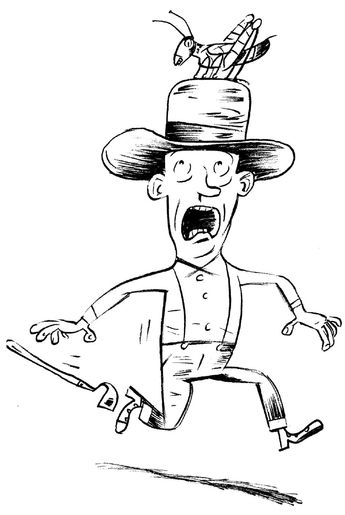
“It was impossible to walk about without killing dozens at each step,” Percy Ebbutt recalled. Men tied strings around the bottom of their pants, hoping to stop the bugs from
hopping into their underwear. There was no way to keep them off your hands or face. Still, farmers felt they had to get out there and do something to protect their crops.
hopping into their underwear. There was no way to keep them off your hands or face. Still, farmers felt they had to get out there and do something to protect their crops.
“Go get your shawls, heavy dresses, and quilts!”
That's what a twelve-year-old girl named Lillie Marcks heard her father yelling when the grasshoppers landed on the family's farm. “We will cover the cabbage and celery beds,” he said. “Perhaps we can save that much.”
Lillie and her five-year-old sister charged out into the storm, swinging branches at the bugs and covering plants with any piece of clothing they could find. It was no use. The grasshoppers simply ate the clothes, then ate everything underneath. Swarms of hoppers chomped down fields of wheat, corn, melons, onionsâeven tobacco. They devoured entire bushes, leaving trees as leafless as they would have been in the middle of winter. When nothing green was left, the bugs started eating wooden fences and the handles of pitchforks.
Grasshoppers also fell into wells by the thousands. Percy Ebbutt had the disgusting job of climbing down his farm's well to try to keep them from ruining the water. “I would then take a small dipper or gourd,” he said, “and skim all the hoppers into the bucket, which was drawn up and emptied by someone at the top.”
The bugs kept coming back, though. Soon the water in wells and creeks all over the plains turned coffee brown with grasshopper droppings. And chickens and pigs ate so many bugs, their meat tasted like grasshopper.
The grasshopper invasion devastated farms all over the plains, from Texas in the south all the way north to the Dakotas. People in other parts of the nation collected donations of money and goods to send to farm families. But getting the stuff there was a challenge, since train tracks on the plains were coated with crushed bugs. The
rails were so greasy with bug juice that train wheels spun helplessly in place, unable to grip the track.
rails were so greasy with bug juice that train wheels spun helplessly in place, unable to grip the track.
H
ardships like the grasshopper invasion drove many farmers away from the Great Plains. Still, the population of plains states continued growing steadily through the 1870s and 1880s.
ardships like the grasshopper invasion drove many farmers away from the Great Plains. Still, the population of plains states continued growing steadily through the 1870s and 1880s.
As more and more people settled in this part of the country, communities started building schools for the local children. These early schoolhouses were often one-room sod shacks, with a stove in the back and blackboard in front. The students sat on long benches without backs, which was especially tough on the kids whose feet didn't reach the ground. “Little legs, dangling high in the air, would ache cruelly,” one teacher remembered.
The teachers were mostly very young women, many as young as sixteenâteaching was one of the few jobs open to them at the time. Mollie Dorsey Sanford took over a schoolhouse in Nebraska when she was twenty. “I have twenty scholars, mostly young children,” she wrote in her journal. “My children range from six to nine years, and of course the younger ones are restless! But I have won their love.”
Since many young teachers were working far from home, local families took turns housing the teachers. The more kids a family had in school, the longer they were supposed to feed and house the teacher. For teachers, this meant they spent the longest amounts of time in the houses that were already the most crowded (and short on food).
Mollie Dorsey Sanford said the lack of privacy in one crowded
cabin really started to bother her. So did the bugs. “At this place I slept on the floor,” she wrote, “and festive bedbugs held high carnival over my weary frame the night through.”
cabin really started to bother her. So did the bugs. “At this place I slept on the floor,” she wrote, “and festive bedbugs held high carnival over my weary frame the night through.”
Are you starting to get the feeling there was no easy way to make a living in the West? That may be trueâthough a young man named Frank Mayer heard of a job that paid really well, at least.
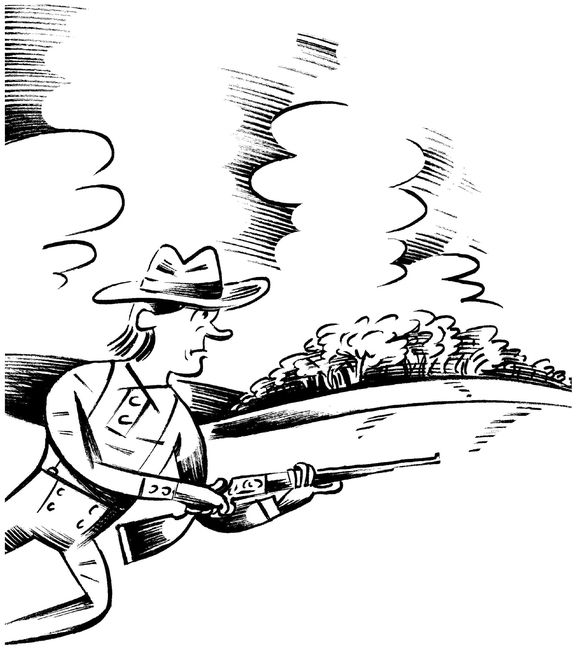
In the early 1870s factories in the East started using buffalo hides to make leather for shoes, belts, and bags. The word spread westâhunters could make a fortune by bringing in buffalo hides. “They were walking gold pieces,” Frank Meyer said of the buffalo. “I was young, twenty-two. I could shoot. I liked to hunt. I needed adventure. Here was it. Wouldn't you have done the same thing if you had been in my place?”
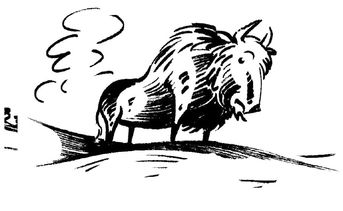
T
here had been about thirty million buffalo in the West when white settlers started arriving. Now buffalo hunters started killing more than a million of them every year. They sometimes blasted buffalo so quickly that their rifles overheated and they had to urinate down the barrels to cool them off. After killing the animals, hunters stripped off the hides, leaving the bodies to rot in the sun.
here had been about thirty million buffalo in the West when white settlers started arriving. Now buffalo hunters started killing more than a million of them every year. They sometimes blasted buffalo so quickly that their rifles overheated and they had to urinate down the barrels to cool them off. After killing the animals, hunters stripped off the hides, leaving the bodies to rot in the sun.
Some hunters didn't even bother to take the hides. A woman named Elizabeth Custer got a close-up view of the buffalo slaughter while heading west by train to meet her husband, an officer in the army. “I have been on a train when the black, moving mass of buffaloes before us looked as if it stretched on down to the horizon,” Custer said. As soon as passengers (the men, that is) spotted the herds, they yanked guns from their suitcases and stuck them out the windows of the moving train.
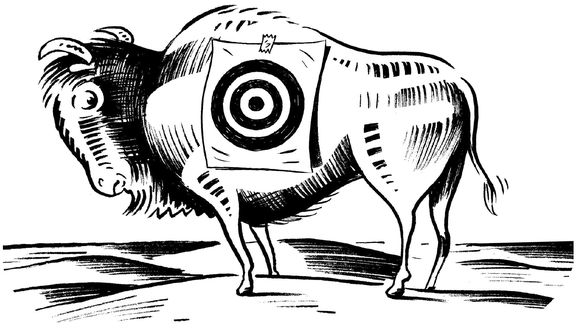
“It was the greatest wonder that more people were not killed,” she said, “as the wild rush for the windows, and the reckless discharge of rifles and pistols, put every passenger's life in jeopardy.”
The men considered this great fun (and like Custer said, only a few passengers got shot). To the Plains Indians, it was cruel and crazy.
“Everything the Kiowa had came from the buffalo,” said one Kiowa woman. “Their tepees were made of buffalo hides, so were their clothes and moccasins. They ate buffalo meat. Their containers were made of hide, or of bladders or stomachs. The buffalo were the life of the Kiowa.” The buffalo were just as important to the Cheyenne, Lakota, and other Plains Indians.
This actually explains why the U.S. government supported the work of buffalo hunters. Once there were no more buffalo to hunt, Plains Indians would no longer be able to roam freely across the plains. Unable to live their traditional way of life, they'd be forced to settle down on reservations.
As General William T. Sherman saw it, killing buffalo was a way of defeating the Plains Indiansâand it was a lot easier (also cheaper and safer) than fighting the Indians directly. “Let them kill, skin, and sell until the buffalo is exterminated,” Sherman said of buffalo hunters. “It is the only way to bring peace and allow civilization to advance.”
It was a harsh strategy. And it was working. “The great buffalo slaughter commenced in the West,” remembered the cowboy Nat Love. “And in 1877 they had become so scarce that it was a rare occasion when you came across a herd containing more than fifty animals, where before you could find thousands in a herd.”
W
ith the buffalo herds disappearing, more Plains Indians groups agreed to move onto reservations. But the Lakota chief Sitting Bull refused to even consider such a move.
ith the buffalo herds disappearing, more Plains Indians groups agreed to move onto reservations. But the Lakota chief Sitting Bull refused to even consider such a move.
As a young boy he had been known by the name Hunkesni, which means “slow.” It wasn't an insult, exactly. It's just that he had a serious stubborn streak, doing everything at his own pace. By 1874, Sitting Bull was a respected chief in his early forties. He was still stubborn too: stubbornly convinced that his people had the right to continue to live free on their own land. As he said to Indians who had agreed to settle on reservations and live on food from the American government:
“The whites may get me at last, as you say, but I will have good times till then. You are fools to make yourselves slaves to a piece of fat bacon, some hard-tack, and a little sugar and coffee.”
Sitting Bull
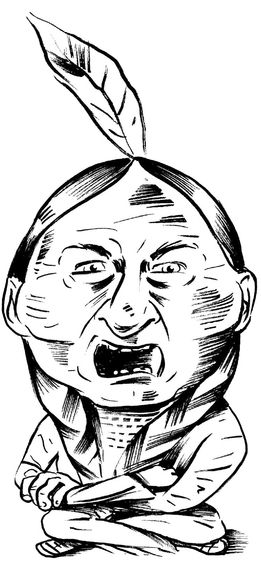
Sitting Bull was confident the Lakota could continue living in their traditional wayâthanks to
the huge Great Sioux Reservation, the territory won by the Lakota in Red Cloud's War. The Black Hills, in what is now South Dakota, were an especially rich hunting region of the Great Sioux Reservation. According the Fort Laramie Treaty between the Lakota and the U.S. government, this land belonged to the Lakota forever.
the huge Great Sioux Reservation, the territory won by the Lakota in Red Cloud's War. The Black Hills, in what is now South Dakota, were an especially rich hunting region of the Great Sioux Reservation. According the Fort Laramie Treaty between the Lakota and the U.S. government, this land belonged to the Lakota forever.
So what was the American army doing there? That's what Lakota leaders were wondering in the summer of 1874 (just eight years after the treaty was signed) as they watched an army officer named George Armstrong Custer lead one thousand American soldiers into the Black Hills. The Lakota knew Custer wellâhe was famous for his flowing blond hair and his aggressive battle style. Once, after chasing a group of warriors for hours without ever getting out of his saddle, the Lakota nicknamed him “Hard Backsides.”

Custer claimed he was in the Black Hills just looking things over, making sure the Lakota were behaving themselves (not that he had any legal right to do that). The truth is, rumors were swirling about gold in those hills. Custer was ordered to go have a look.
“Our people knew there was yellow metal in little chunks up there,” said a Lakota
teenager named Black Elk. “But they did not bother with it, because it was not good for anything.”
teenager named Black Elk. “But they did not bother with it, because it was not good for anything.”
Custer did not agree. “We have discovered a rich and beautiful country,” he wrote to his wife, Elizabeth (without explaining how you can “discover” a country where other people are already living). He was thrilled by the opportunity to add to his growing collection of western wildlife: “I have one live rattlesnake,” he told Elizabeth, “two jack-rabbits, half-grown, one eagle, and four owls. I had also two fine badgers, full-grown, but they were accidentally smothered.”
More important, Custer's soldiers squatted in streams to pan for gold. It was there, all right. “We have discovered gold without a doubt, and probably other valuable metals,” he reported.
Sitting Bull watched Custer's army march out of the Black Hills and back toward American territory. There would be no fighting that summer. The Lakota just watched and waited and wondered what the Americans were really up to.
T
hey found out soon enough. Custer's discovery was headline news all over the country. “Rich Mines of Gold and Silver Reported Found by Custer,” announced one newspaper. This set off a new gold rush, with thousands of miners swarming into the Black Hills.
hey found out soon enough. Custer's discovery was headline news all over the country. “Rich Mines of Gold and Silver Reported Found by Custer,” announced one newspaper. This set off a new gold rush, with thousands of miners swarming into the Black Hills.
The American army was legally required to remove the miners. But the government decided it would be simpler just to buy the Black Hills. “You should bow to the wishes of the government,” one senator told Lakota leaders. “Gold is useless to you, and there will be fighting unless you give it up.”
When Sitting Bull heard the government was setting up a conference to work out a price for the Black Hills, he sent a message to President Grant. “I want you to go and tell the Great Father that I do not want to sell any land to the government,” he told an interpreter. Picking up a pinch of dust, he added: “Not even as much as this.”
The government officials came west anyway and tried negotiating with the few chiefs who were willing to talk. It did not go well. The government offered six million dollars for the Black Hills. Far too low a price, the chiefs responded. While the arguments flew back and forth, three hundred Lakota warriors rode up to the outdoor meeting. Holding rifles high in the air, they sang a new song specially written for the occasion:
The Black Hills is my land and I love it
And whoever interferes
Will hear this gun.
And whoever interferes
Will hear this gun.
The frustrated (and nervous) government men hurried back to Washington, D.C., to report their failure. At this point, President Grant and General Sherman decided they were done negotiating. They sent a warning to Sitting Bull and the other Lakota leaders: Report to reservations by January 31, 1876âor the army will come and bring you in.
T
he job of actually going and getting the Lakota fell to American soldiers stationed in western forts. Here was yet another very tough way to make a living in the West.
he job of actually going and getting the Lakota fell to American soldiers stationed in western forts. Here was yet another very tough way to make a living in the West.
Low-paid soldiers spent years stuck in small log forts, hundreds of miles from anywhere. The loneliness and boredom were unbearable. So was the food, which included case after case of moldy biscuits left over from the Civil War.
There were unexpected troubles too, as Martha Summerhayes discovered. Martha's husband, Jack, an army lieutenant, was assigned to a fort in the West. Like many officers' wives, she decided to go with him.
“Our sleeping room was very small,” she said, “and its one window looked out over the boundless prairie at the back of the post.” Summer nights were baking hot, and they had to sleep with their window wide open. Along with a slight breeze, this let in the growls of mountain lions. Nothing to worry about, her husband assured her.
One night the cat cries seemed a little closer. “I asked him if they ever came in,” Martha remembered.
“Gracious, no!” Jack said. “They are too wild.”
So she tried again to get comfortable in bed.
“I calmed myself for sleepâwhen like lightning, one of the huge creatures gave a flying leap in at our window, across the bed, and through into the living-room.”
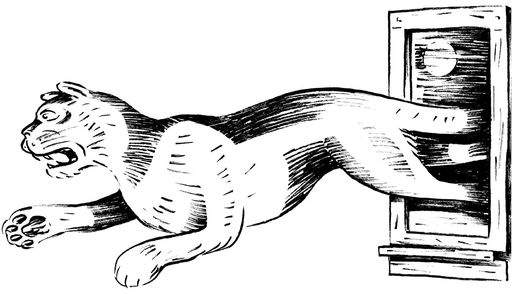
“Jerusalem!” shouted Lieutenant Summerhayes.
He tumbled out of bed, grabbed his sword from the corner, and, swinging and stabbing wildly, chased the wild cat back into the bedroom, onto the bed, over Martha, and out the open window.
Nothing this exciting (or dangerous) usually happened in western forts. The two biggest health hazards in the forts were disease and alcohol abuse. Soldiers were often so bored that they welcomed the chance to march off toward battle.
That's exactly what happened in May 1876. The government's deadline had come and gone. Sitting Bull and most of the Lakota still refused to surrender. “I think we will have some hard times this summer,” a soldier named T. P. Eagan wrote to his sister. “The old chief Sitting Bull says that he will not make peace with the whites as long as he has a man to fight.”
Other books
Geoffrey Condit by Band of Iron
The Cat Who Played Post Office by Lilian Jackson Braun
Where Love Dwells by Delia Parr
Stag's Leap by Sharon Olds
And Then She Killed Him by Robert Scott
Always Devoted by Karen Rose Smith
Rising Moon (The Rune Stone Trilogy) by Haley, Anne
L. Frank Baum_Oz 12 by The Tin Woodman of Oz
First Salute by Barbara W. Tuchman
Dark Steel: A Motorcycle Club Romance Novel by Jones, Olivia
